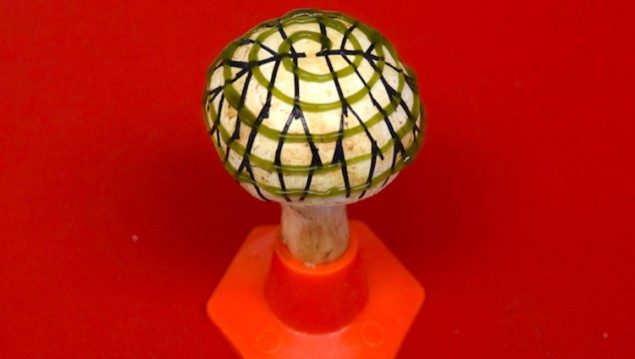
Researchers at the Stevens Institute of Technology in New Jersey have used 3D printing to fabricate the first ever bionic mushroom. The structure, which is made from an ordinary button mushroom whose cap is patterned with energy-producing cyanobacteria and graphene nanoribbons printed alongside the bacteria, is capable of generating around 65 nanoamps of current. While not enough to power an electronic device, an array of such mushrooms could provide enough current to power a light-emitting diode.
“We report on seamless merging of cyanobacteria (Anabaena) and functional nanomaterials via a 3D printing technique,” says team leader Manu Mannoor of the Neuro-Bionics and Neuro-Electric medicine Laboratory at Stevens. “Our goal was to better access the unique properties of both these components, augment them and create an entirely new functional bionic architecture on a mushroom.”
Cyanobacteria boast an unmatched internal quantum efficiency of nearly 100% for photosynthetic energy conversion – the result of 2.5 billion years of evolution, he explains. Such organisms are nature’s most efficient antenna systems for absorbing photons from the Sun and systematically directing them to reaction centres (made up of enzymes), followed by separation of charges (electrons and holes). This separation in space means that they are unable to neutralize one another by charge recombination and the electrons are thus available to produce a photocurrent.
Densely-packed cyanobacterial cells
Thanks to 3D printing, the team was able to assemble densely-packed cyanobacterial cells in an anisotropic pattern on the mushroom’s pileus (cap), whose porous structure is ideally suited to such a purpose. This arrangement boosts the amount of bioelectricity the cells are able to produce compared to isotopically-casted bacteria (using a simple laboratory pipette), explains study first author Sudeep Joshi.
“Ours is an artificial symbiosis between the mushroom and the cyanobacteria/graphene nanoribbons in which the mushroom provides the right biophysiological conditions, such as shelter, moisture, nutrients, suitable pH conditions and temperature. Such mutually beneficial symbiosis naturally occurs in many living organisms but we have exploited it in an engineered device.”
The researchers began by 3D printing an electronic ink (which has a conductivity of around 0.47 S/cm) containing graphene nanoribbons onto a mushroom’s cap in a Fibonacci series pattern to act as a working electrode. They selected this specific pattern because it produces a uniformly branched electrode network that efficiently covers almost all of the pileus surface area. They then extended this electrode through the stem of the mushroom.

Is photosynthesis quantum-ish?
Activating photosynthesis
“Next, we 3D printed a bioink containing cyanobacteria onto the cap in a spiral pattern that intersected with the electronic ink at multiple points,” says Joshi. “At these contact sites, electrons transfer through the outer membranes of the cyanobacteria to the conductive network of the graphene nanoribbons when we shine a light source on the mushroom. This activates photosynthesis in the cyanobacteria that generate bio-electrons, which are then driven under an applied bias voltage in an electrochemical set-up.”
The techniques developed in this work, which is published in Nano Letters 10.1021/acs.nanolett.8b02642, could be extended to 3D print other types of bacterial colonies with materials such as hydrogels, Mannoor tells Physics World. “Such structures could be used to advance studies on bionic hybrids like the ones we have made and be used to develop next-generation devices that perform other useful functions, such as bioluminescence.”
The researchers say they are now looking at ways to generate higher currents using their system.



